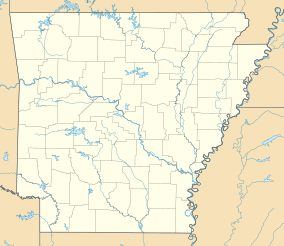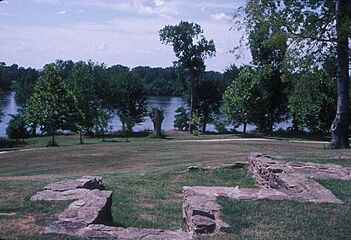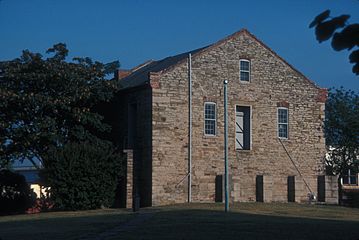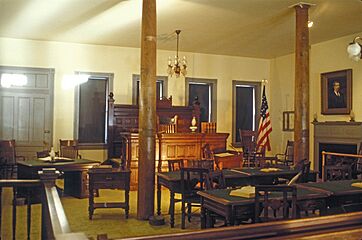Fort Smith National Historic Site facts for kids
Quick facts for kids Fort Smith National Historic Site |
|
|---|---|

Fort Smith National Historic Site in 2009
|
|
| Location | Sebastian County, Arkansas |
| Nearest city | Fort Smith, Arkansas |
| Area | 75 acres (30 ha) |
| Established | September 13, 1961 |
| Visitors | 86,122 (in 2011) |
| Governing body | National Park Service |
| Website | Fort Smith National Historic Site |
| Designated: | October 15, 1966 |
| Reference #: | 66000202 |
| Designated: | December 19, 1960 |
The Fort Smith National Historic Site is a special place in Fort Smith, Arkansas, right along the Arkansas River. It protects the remains of two old forts built by the United States. The first fort was set up in 1817. The second fort operated until 1871.
This site also became famous for its federal court. This court handled important cases for western Arkansas and the nearby Indian Territory. A well-known judge named Isaac C. Parker worked here for twenty years. The city of Fort Smith grew up around these important historical sites.
Contents
Exploring Fort Smith's Historic Grounds
When you visit Fort Smith National Historic Site, you can see many interesting things. You'll find the remains of the very first Fort Smith, which was used from 1817 to 1824. There's also the commissary building, built around 1838, where supplies were kept.
You can also see a reconstruction of the gallows. These were used by the federal court for serious cases. A walking trail along the Arkansas River has signs that tell the story of the Trail of Tears. This was a sad time when many Native American people were forced to move from their homes.
What to See at the Visitor Center
The park's visitor center is inside an old building that used to be barracks, a courthouse, and a jail. Inside, you can learn about Fort Smith's military past from 1817 to 1871. Exhibits also show how the fort helped with the expansion of the United States to the west.
You'll learn about Judge Isaac C. Parker and how the federal courts brought justice to the Indian Territory. There are also stories about the U.S. Deputy Marshals and outlaws. You can also learn about the government's policies toward Native Americans and the Trail of Tears.
A Look Back at Fort Smith's History
The Fort Smith National Historic Site was created in 1961. Its purpose was to protect the remains of two important 19th-century military forts. It also protects the building that once housed the federal court. This court handled many cases in the Indian Territory.
Fort Smith was also a major stop for the Choctaw and Cherokee people. They passed through here during the "Trail of Tears." This was when Native Americans were moved from their lands in the Southeast.
The First Fort: Keeping the Peace (1817-1824)
The very first fort was built on December 25, 1817. Major William Bradford led its construction. The fort's main goal was to help keep peace between the local Osage Indians and the Cherokee people. The Cherokee had moved west due to pressure from European American settlers.
This "First Fort" was used until 1824. The U.S. Army left Fort Smith after building Fort Gibson further west.
The Second Fort: A New Purpose (1838-1871)
Tensions grew between Native Americans and white settlers after the Indian Removal Act of 1830. Because of this, the U.S. Army built a second Fort Smith in 1838. It was located near the ruins of the first fort. This began the "Second Fort" era.
In the 1840s, under General Zachary Taylor's command, the fort became a supply center for other forts in the Indian Territory. During the American Civil War, Union troops captured the fort from Confederate forces in 1863. Many Cherokee and other Native American tribes had sided with the Confederacy. The fort continued to be a supply depot until 1871, when it was no longer officially used by the military.
The Federal Court at Fort Smith
As often happens, a small town grew around the fort. People came for business and opportunities. In 1851, the United States Congress created the federal court for the Western District of Arkansas. This court enforced federal law in western Arkansas and the Indian Territory. It also handled crimes involving U.S. citizens.
Judge Parker's Time in Court
After the Civil War, the court moved to Fort Smith in 1872. It first met in a building downtown. Later, after a fire, the court moved to the recently empty military fort property in late 1872.
In 1875, President Ulysses H. Grant appointed Isaac C. Parker as the new judge for the Western District of Arkansas. Judge Parker was 36 years old when he started court on May 10, 1875. He served for twenty years, mostly at "the Old Fort." His time as judge made his name famous in Western history. Many stories, some true and some legendary, grew around him and his court, known for its tough justice.
Image gallery
- Arkansas in the American Civil War gallery
See also







